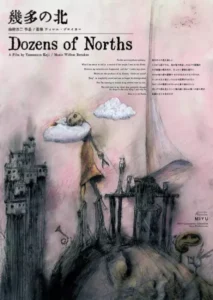Ikuta no Kita
Dozens of Norths / 幾多の北 / Des dizaines de Nords
| Genres: Adventure, Award Winning, Fantasy, Psychological, Suspense | |
| Themes: Psychological | |
| Studios: Yamamura Animation, Inc. | |
| Producers: Miyu Productions | |
| Rating: 6.44 / 10 | |
| Rank: #7618 | |
| Popularity: #11377 | |
| Users Listed: 2,558 | |
| Users Scored: 501 | |
| NSFW: No | |
| Last Updated: 01/07/2023 | |
| Aired: November 6, 2021 (Fall) | |
| Type: movie | |
| Source: other | |
| Age Rating: R | |
| Episodes: 1 |
Synopsis:
The narrative unfolds within a desolate, seemingly endless Northern expanse – a landscape defined by isolation and repetition. The story follows a character grappling with fragmented memories, documenting encounters with individuals encountered across this vast region. A sense of disorientation permeates the experience as the protagonist questions the purpose of their efforts and the very nature of their surroundings. The anime explores themes of identity and existence within a stark, almost dreamlike environment. Progress is marked not by grand achievements but by subtle shifts in perception and the infrequent acknowledgment of a larger world beyond immediate experience. It’s a contemplative journey into the subjective experience of being, emphasizing atmosphere over action, inviting viewers to piece together meaning alongside the protagonist.
Trailer:
You May Also Like:
Staff:
- Yamamura, Koji (Director, Script, Editing)
- Kasamatsu, Kouji (Sound Director)
- Nakata, Ayaka (Key Animation)
- Yamamura, Sanae (Special Effects, Production Assistant)
- Yano, Honami (In-Between Animation)
Reviews:
-
User Tefashi (Score: 9/10):
Give this hidden gem a try it may seem much experimental and non sense but this happens too in animes like Nido to Mezamenu Komori Uta, Ningen Kousaten etc but the point is that this has a message and I'll try to explain it in my review This anime for me represents an illusion of the time passage one slow apprehension planted in the furthest place of the mind. The memories seem all to be in the way of the North but the North is here and there but unfortunately nowhere, while the fractured memories are effectively unmoving in a repeated cycle or headed somewhere, seemingly north.The cardinal direction is of little importance in and of itself, but it refers to the universal knowledge that one should head towards a straight path in times of neednnI really love Yamamura's style and in this one is no exception it has the essence of any other that his pasts works had he really knows how to create a philosophical movie nn9/10nA fusion of dystopian movie and adventure with a taste of philosophy -
User Halcyon13 (Score: 9/10):
An illusion of time's passage, latent apprehension firmly planted in the furthest crevices of minds. The North exists here and there, everywhere but alas, nowhere. It is simply a state of immobility and disorientation experienced by anyone with a dream of something more. Yamamura's otherworldly imagery is dense in detail, while the fractured memories are effectively unmoving in a repeated cycle or headed somewhere, seemingly north. The cardinal direction is of little importance in and of itself, but it refers to the universal knowledge that one should head towards a straight path in times of need. A consensus that without direction in one's aspirations, they'rebound to be stuck in a limbo of nothingness. The film feels like a daydream, not in the sense that it's unmemorable, however, it's always happening as I'm consuming the atmosphere, genuinely alive right in front of my eyes. It encompasses the human condition in all its inglorious despondency, in which we retain sanity by performing menial tasks.nnThe fictional location depicted in Dozens of Norths is nightmarishly dreary yet expansive, where humans and grotesque creatures coexist. Yamamura will often establish an elaborately composed shot similar to pictures in wimmelbooks, although less populated. The camera then focuses on different sections of the frame, allowing a closer look at the subliminal movements of residents who are stationarily drooped as to indicate depressive fatigue, isolation denoted by existence itself. Other times, we're taken on a tour through the stuff of fantasies, like a dream factory, and Yamamura laterally tracks each individual continually occupied in a pattern of meaningless effort. In search of an escape from fear and suffering, only a purpose can keep our resolve intact, a duty that won't abandon us since we've already abandoned ourselves. The invisible lingering anxiety drowns the film in strong nihilism, albeit it never insists that being unable to relax in thought is a futile dilemma.nnYamamura opts for a relatively unorthodox style of silent narration, where short lines of text periodically appear on-screen to communicate the abstract intentions of each separate scene, sometimes shot-by-shot. The aphorisms that are used are meant to provoke a more profound perspective on what would otherwise be highly ambiguous animation. In retrospect, the absence of dialogue is a major factor in successfully experimenting with the poetic mix of art and music. Willem Breuke's jazzy touch is accompanied by haunting shrieks following every beat of motion, and when we are immersed in the quietude, Koji Kasamatsu's sound design of winds and waves is cold to the ears. Alongside its thematic force, Dozens of Norths is an audiovisual delight, boasting unusual designs, messy line art, and freefall control over its characters.nnAlienation persists whether or not we believe we overcame such mental hurdles, as it's a part of comprehensive perception. Occasionally, we see two small men carrying a quill, traversing the landscape at the corners of different frames. The feather is nearly weightless, yet a subconscious burden that they're designated to carry beyond their North. This recurring scene parallels the existential… -
User off-season (Score: 6/10):
A series of surreal animated setpieces connected by motifs and implications rather than anything resembling a story. As surrealism, it's more John Ashbery than Kunihiko Ikuhara: there's no dialogue or narration, instead scenes are punctuated by gnomic intertitles that together have the feeling (to me at least) of an oblique prose poem on the nature of artistic creation. The relationship between the scenes and the intertitles is less than obvious, and some of the interest in the film is probably in the way the two intersect and complement each other. Which goes to say, this is a pretty challenging watch and I can't say Ihad the energy to concentrate on it properly. Maybe I'll give it another shot some day. - ... and 2 more reviews

























